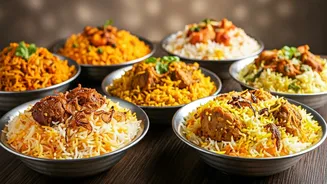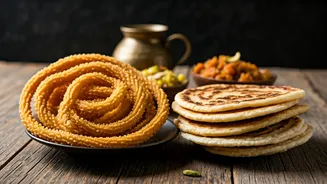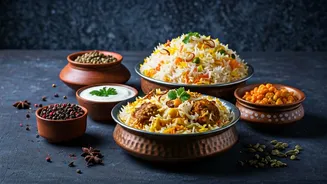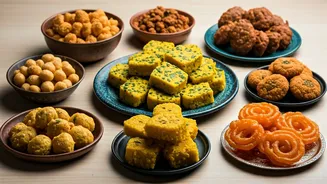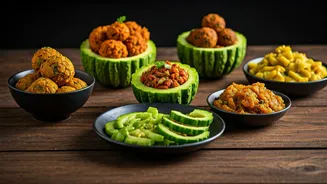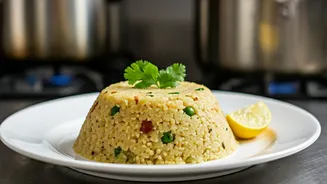Hyderabadi Biryani
Hyderabadi biryani is arguably the most well-known. This style is characterized by its use of the 'dum' method, where the meat and rice are cooked together
in a sealed pot, allowing the flavors to meld beautifully. The meat, typically chicken or mutton, is marinated in a blend of yogurt, spices, and herbs for several hours, sometimes overnight, before being layered with basmati rice and cooked over low heat. The spices used often include saffron, cardamom, cloves, cinnamon, and bay leaves, which give the biryani its distinctive aroma and taste. It's often served with raita, a yogurt-based side dish, and mirchi ka salan, a chili-peanut curry, to balance the richness of the dish. The 'katchi' (raw) biryani, where raw meat is layered with rice, and 'pakki' (cooked) biryani, where the meat is partially cooked before layering, are two main variations. The slow cooking process allows the flavors to penetrate the rice and meat, resulting in a dish that's rich, aromatic, and deeply flavorful, making it a favorite across the country and beyond.
Lucknowi Biryani
Lucknowi biryani, also known as 'Awadhi biryani,' is celebrated for its delicate flavors and refined cooking style. This biryani is known for its milder spice profile compared to Hyderabadi biryani, with a focus on subtlety and aromatic elements. The meat, typically chicken or mutton, is marinated in yogurt and a blend of less intense spices like saffron, rose water, and kewra (pandanus flower water), which lend a fragrant and floral aroma. The rice is often partially cooked separately before being layered with the meat, and the cooking is done using the 'dum' method. The use of ghee (clarified butter) is prominent, adding richness and a melt-in-your-mouth texture. The final touch often includes garnishing with fried onions, coriander leaves, and sometimes even edible silver leaf. The emphasis is on gentle cooking to preserve the integrity of the flavors, creating a biryani that is light, aromatic, and pleasing to the palate, showcasing the elegance of Awadhi cuisine.
Kolkata Biryani
Kolkata biryani is a unique adaptation of the Lucknowi style, modified during the British colonial era. This biryani is lighter and sweeter compared to other variants, often including boiled potatoes and a generous helping of saffron and nutmeg. The meat, usually chicken or mutton, is marinated in a spice mixture that includes mace, cardamom, and cinnamon, giving it a distinctive aroma. The addition of potatoes is a key characteristic, and they soak up the flavors of the meat and spices, making them a delicious accompaniment. The rice is typically cooked separately and layered with the meat and potatoes, then cooked using the 'dum' method. The Kolkata biryani is also known for its subtle sweetness and the use of rose water. The final product is a fragrant and flavorful biryani that combines the richness of meat and rice with the unexpected sweetness of potatoes, creating a unique culinary experience that is beloved by the people of Kolkata.
Sindhi Biryani
Sindhi biryani hails from the Sindh region of Pakistan (now part of Pakistan, but culturally related to India) and is known for its robust and spicy flavors. This biryani is characterized by its generous use of spices, including red chilies, coriander, cumin, and garam masala, which give it a bold and fiery taste. The meat, often mutton or goat, is marinated in a mixture of yogurt, spices, and ginger-garlic paste for several hours to enhance the flavors. A unique element is the inclusion of potatoes and plums, which add both sweetness and texture. The rice and meat are layered in a pot and cooked using the 'dum' method, often with tomatoes and fried onions to boost the taste. The use of mint and green chilies also contributes to the biryani's freshness and heat. Sindhi biryani is a flavorful, aromatic dish that is perfect for those who enjoy a spicier meal. The dish is known for its complexity, as the numerous ingredients blend harmoniously to create a rich and memorable dining experience.
Malabar Biryani
Malabar biryani, originating from the Malabar region of Kerala, offers a distinct flavor profile due to the use of local spices and ingredients. This biryani often features a combination of chicken or seafood, alongside a rich blend of spices like black pepper, cardamom, cloves, and cinnamon. The meat or seafood is marinated in a mixture of spices and yogurt before being cooked with the rice. A unique element of this biryani is the use of ghee and coconut milk, which imparts a rich and creamy texture, adding a subtle sweetness. The rice and meat are layered together and cooked in the 'dum' method, creating a dish with a strong aromatic appeal and a complex flavor profile. The Malabar biryani is typically served with raita and lime pickle to balance the richness. The freshness of the spices and the delicate balance of flavors make Malabar biryani a celebrated dish in South India and beyond, demonstrating the region's rich culinary legacy.
Dindigul Biryani
Dindigul biryani, from the town of Dindigul in Tamil Nadu, is famous for its unique spice blend and tender meat. The biryani is known for using a special blend of spices, which include fennel seeds, black pepper, and yogurt, alongside the more conventional spices like ginger and garlic, giving it a distinctive and slightly tangy flavor. The meat, typically goat or chicken, is marinated in yogurt and the special spice mix overnight, infusing the meat with flavor. The rice is usually cooked separately to maintain its texture, and the biryani is often cooked with the 'dum' method to allow all the flavors to meld. A defining characteristic of Dindigul biryani is the use of lemon juice, which adds a refreshing zest. The biryani is also known for its use of seeraga samba rice, a short-grain rice variety that enhances the overall taste. It is generally served with onion raita and other accompaniments, which complement its rich flavor profile. The Dindigul biryani has a widespread appeal because of its unique blend of spices and tender meat, reflecting the region's strong culinary traditions.
